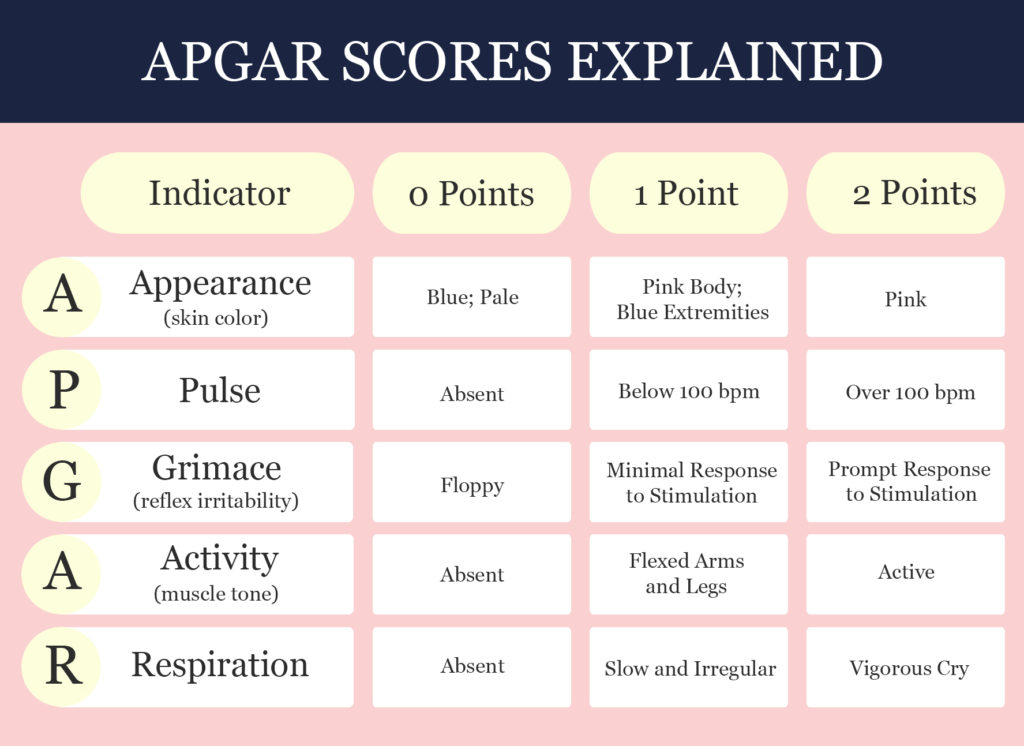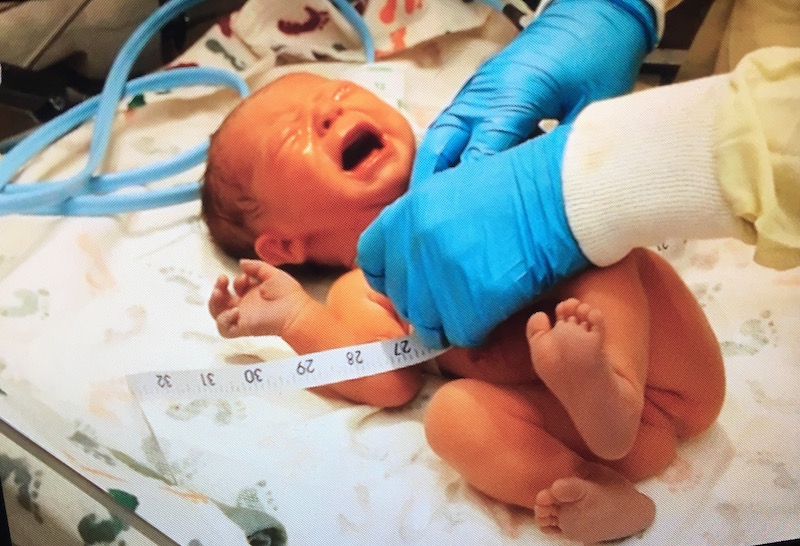Here’s what to expect in baby’s first 24 hours. Learn what’s normal for baby’s appearance, breathing, pulse, and more… plus learn all about those important newborn screenings!
Welcoming a new baby into your life can be somewhat overwhelming. You will have important decisions to make at every turn. Your familiar routines are now changed, and your biggest concern is now focused around your baby’s health and safety.
I am here to hopefully make things a little less daunting (and to reduce your need to Google everything!), as I go through what to expect in baby’s first 24 hours! So let’s get started!
(By the way, make sure to check with your pediatrician if you have any concerns or are not sure. I’m just sharing my experiences and the advice I have received, but I am in no way qualified to give medical advice on your sweet new baby).
RELATED: Easy Activities for Newborn Babies

RELATED: Choosing a Pediatrician: 25 Questions to Ask (Printable Checklist!)
Apgar Score – Newborn Screening
The apgar score is a quick and easy test that evaluates your baby’s well being at 1 minute and then again at 5 minutes after birth. Below is a chart showing the 5 areas in which your baby is scored.

Newborn Appearance After Birth
As your baby is born you may notice that he/she is slippery, wet, and may possibly be covered in a white substance known as vernix caseosa. Vernix helps protect the baby’s skin from infection and wrinkling while in the amniotic fluid.
Most of the vernix will have disappeared by the time your baby is born. Although the earlier your baby is born (premature or late-preterm) the more vernix you’ll see.
Right after birth, the OB or midwife will cut the cord or give the option of cutting the cord to your support person. Your baby will then be immediately placed on your chest for skin-to-skin contact or handed off to the nurse to be assessed and given oxygen if need be.
Molding

Don’t freak out if your baby’s head appears oddly shaped right after birth. When newly born, the plates of your baby’s skull bones are not fused together. This allows a baby’s head to move through the narrow birth canal and also allows for your baby’s rapidly growing brain during infancy. This is referred to as molding.
Your baby will also have two soft spots on their head, known as fontanelles. These are the areas where the skull bones haven’t grown together yet. There is one at the top of the skull and one at the back.
RELATED: The 12 Essential Postpartum Supplies I *Actually* Used
Milia
Your baby’s nose may appear flattened, with white pimple looking bumps. These are completely normal, and are known as milia. They are clogged pores that will eventually go away.
Lanugo
Your baby may look a bit fuzzy and that’s okay! This is called lanugo, fine, soft hair that appears all over your baby’s body. It helps in protecting the baby’s skin while developing inside your uterus. You may notice that premature infants are typically born with more lanugo than full term babies.

RELATED: What I’m Packing in My Hospital Bag (for Baby #2)
Eyes
When born, all baby’s eyes tend to be bluish-gray in color. You will not actually know the true color until around 6-9 months of age. At birth, they can also see up to around 12 inches.
Genitals
Boys typically have swollen scrotums, due to the pressure that is placed on them as they maneuver their way down the birth canal.
Girls tend to have swollen labia, along with mucous discharge. This is due to the hormones that are passed from her mother. Around the fifth day after birth, girls may have blood-tinged mucous. This is completely normal, and again caused from hormones, from mom.
Newborn Baby Skin
The baby may have “stork bites,” or little pink spots. They are typically found on the forehead, chin, eyelids, and the back of the neck. These are not birthmarks and most will fade with time. Although, the ones on the back of the neck may not completely go away.
When born, the baby’s hands and feet may appear blue in color. This is normal and known as acrocyanosis. They may remain blue in color for up to 24 hours. All the oxygenated blood will rush to the heart, lungs, brain, and all other vital organs first. The hands and feet are the furthest from the heart and can wait until all the vital organs are nourished.

RELATED: What is Cord Blood Banking (and Why Your Family Might Want to Consider It)
Umbilical Cord
Your baby’s umbilical cord will be clamped and cut close to your baby’s body, leaving an umbilical stump. This stump will typically dry up and fall off in about 1-3 weeks.
Before you’re discharged, your healthcare provider will review with you the care of the umbilical stump.
It’s important to keep your baby’s umbilical stump dry and clean. Parents were once instructed to swab the stump with rubbing alcohol, but that’s no longer the case. Instead, take a cotton ball and dip in warm water, squeezing out the excess water. Dab the cotton ball around the stump, to clean.
Expose the stump to air to help dry out the base. Until this stump falls off, it’s best to give your baby sponge baths so it’s easier to keep dry. And of course, never pull on the stump! Let the stump fall off on its own!
You can also folded down the front your baby’s diaper a little so it doesn’t rub over the area.
Eye Prophylaxis
In most states it is required by law for babies to receive treatment for their eyes to protect them from an infection called gonorrhea. This type of infection, passed from the mother, was once the leading cause of blindness in newborns.
Thankfully, measures have been put in place to provide intervening treatment for infants so these numbers have dropped significantly. Instead of testing every single mother, treatment is provided, prophylactically, to be safe.
The treatment is as easy as placing eye drops or ointment containing an antibiotic medication on the baby’s eyes after birth. It may cause the baby’s eyes to become swollen or inflamed, but it will clear up in a day!

RELATED: Baby Registry Essentials & Lifesavers
Vitamin K
At birth, your baby’s production of Vitamin K will be low, so they’ll need a little boost. Vitamin K helps with blood coagulation and decreases the risk of bleeding. Your newborn will receive a single shot to get those levels up.
However, studies show that most infants and children continue to have a Vitamin K deficiency. Knowing this, you may want to purchase some Vitamin K drops to stay on top of it. These drops are odorless, tasteless, and easy to administer.
Vitamin K2 also plays other important roles in the health of children like promoting cardiovascular health and bone mineralization.
Newborn Screenings
Metabolic Screening
Metabolic screening tests for genetic, developmental, and metabolic disorders in newborns. Some of these conditions may not be visible right at birth, so screening is able to identify disorders early.
If a rare condition is detected, early treatment can help to avoid severe health problems in your child down the road.
This screening is performed by taking a few drops of blood from your baby’s heel and sending them off to lab for analysis.
Hearing Screening

The most common congenital disorder in newborns is hearing loss. For this reason, hearing screenings are now common practice before a newborn leaves the hospital. If hearing loss is not caught early on, it can result in an absence of stimulation of the brain’s hearing center. This can in turn create a setback in speech development along with other developmental milestones for your baby.
RELATED:10 Tips to Prepare for (and Enjoy) Baby’s First Bath as a Family
Pulse Oximetry Screening
Federal health officials are advocating that all newborns undergo pulse oximetry screening, with several hospitals accommodating this practice. Pulse oximetry screening is done to measure how much oxygen is in your baby’s blood which can detect congenital heart diseases in newborns.
This procedure is simple and non-invasive. A device is placed on your baby’s hand or foot, with connection to a monitor. This monitor can then measure your baby’s blood oxygen level in approximately sixty seconds, with absolutely no puncture to the baby’s skin.
Final Thoughts on What to Expect in Baby’s First 24 Hours

I hope you feel more confident and prepared now that you’ve learned what to expect in baby’s first 24 hours. The newborn phase comes with a steep learning curve, but you’ll get the hang of it! Remember, you can ask as many questions as you need to feel comfortable during and after your delivery. Your doctors and nurses or midwife are there for YOU and your baby!
You may also enjoy:
Did you find this helpful? Please share this post with a friend and save it for later on Pinterest!


